Experimental Study on the Interface Characteristics of Reinforced Crushed Rock Cushion Layer Based on Direct Shear Tests
Abstract
:1. Introduction
2. A New Subgrade Structure Based on the Interlocking Interaction between Concrete Sloped Toe Wall and Mattress
3. Experimental Research
3.1. Direct Shear Test Equipment
3.2. Materials
3.2.1. Crushed Rock Aggregates
3.2.2. Geogrid
3.3. Test Program
3.4. Sample Preparation
4. Results and Discussion
4.1. Strength Characteristics of the Crushed Rock Aggregates
4.1.1. The Shear Force–Shear Displacement Curve of the Crushed Rock Aggregates
- (1)
- Linear growth stage: In the initial stage, the shear force–shear displacement curve of the unreinforced crushed rock aggregate exhibits a nearly linear rapid growth phase. As the normal pressure increases, the shear force of the crushed rock aggregates increases at a faster rate with shear displacement. The slope of the initial straight line also becomes steeper. Conversely, for the PL geogrid-reinforced crushed rock aggregates, as the normal pressure increases, the growth rate of the shear force becomes slower, and the slope of the initial straight line becomes lower;
- (2)
- Fluctuation Growth Stage: With the increase in shear displacement, the shear force gradually and slowly fluctuates and grows until it reaches the peak shear force. During the shearing process, the shear “jumping” phenomenon occurs due to the uneven gradation of the crushed rock aggregates, shear displacement, flipping, and fragmentation of the gravel particles. The shear force–shear displacement curve of the crushed rock aggregate is significantly influenced by the normal stress. The higher the normal stress, the greater the shear force of the crushed rock aggregates and the larger the shear displacement required to reach the peak shear force (except for 50 kPa). This is mainly because, at lower normal stresses, the rolling and repositioning of aggregate particles are relatively easy, allowing them to quickly reach a more stable state. On the other hand, higher normal stresses restrict the repositioning of crushed rock aggregate particles, requiring larger shear displacements to reach a stable state. In the direct shear process, the reinforced geogrid significantly influences the shear force of the crushed rock aggregate. The shear force of the PL geogrid-reinforced crushed rock aggregate is reduced compared to the shear force of the unreinforced crushed rock aggregate;
- (3)
- Shear Failure Stage: After reaching the peak shear force, the shear force-shear displacement curve gradually forms a continuous shear failure plane, and the “jumping” phenomenon in the shearing process continues. The shear force fluctuation decreases; the higher the normal stress, the more pronounced the downward trend. Compared to the PL geogrid-reinforced crushed rock aggregates, the unreinforced crushed rock aggregate shows a more pronounced downward trend.
4.1.2. Evolution of Interface Shear Strength of Crushed Rock Aggregates
4.1.3. Interface Direct Shear Parameters of the Crushed Rock Aggregates
4.2. Deformation Characteristics of Crushed Rock Aggregates
4.2.1. Vertical Displacement–Shear Displacement Curve of Crushed Rock Aggregates
4.2.2. Peak Compression and Peak Dilation Angle of Crushed Rock Aggregates
4.3. Crushing Characteristics of Crushed Rock Aggregates
4.3.1. Variation in Aggregates Composition
4.3.2. Relative Breakage Potential of Crushed Rock Aggregates
5. Conclusions
- (a)
- Under different normal stresses, the shear force–shear displacement curves of crushed rock aggregates exhibit peak values, showing typical strain-softening behavior. The higher the normal stress, the greater the shear displacement required to reach the peak shear force. The shear force–shear displacement curve of crushed rock aggregates becomes more stable when the geogrids were added, exhibiting a weak strain-softening behavior;
- (b)
- The shear strength of crushed rock aggregate exhibits a non-linear increasing trend with increasing normal stress. The shear strength of the crushed rock aggregate decreased when the geogrids were added. The attenuation of shear strength is particularly significant at low normal stresses, with a maximum attenuation amplitude of 35.7%;
- (c)
- The peak friction angles () of reinforced crushed rock aggregate decrease nonlinearly with an increase in normal stress. The apparent friction coefficient (f*) also decreases nonlinearly with an increase in normal stress. However, after the normal stress reaches 100 kPa, the variation of the apparent friction coefficient tends to stabilize;
- (d)
- The shear strain–vertical displacement curve of the crushed rock aggregate exhibits an evolution pattern of shear contraction followed by shear dilation. The crushed rock aggregate experiences significant attenuation in terms of peak compression and peak dilation angle () when the geogrids were added, with maximum attenuation amplitudes of 47.8% and 40%;
- (e)
- The particle size distribution of crushed rock aggregate before and after shearing mainly shows an increase in the content of small and medium-sized particles and a decrease in the content of large-sized particles. Geogrid reinforcement has a significant impact on the fragmentation characteristics of the crushed rock aggregate and reduces its relative breaking potential (Br).
Author Contributions
Funding
Institutional Review Board Statement
Informed Consent Statement
Data Availability Statement
Conflicts of Interest
References
- Wang, X.C.; Ding, L.T.; Gao, W.Z.; Zhang, M.Y.; Fu, L.J. Research on Subgrade Differential Settlement Control Standard and Treatment Technology Based on Driving Comfort. Adv. Mater. Sci. Eng. 2020, 2020, 8956458. [Google Scholar] [CrossRef]
- Chen, C.; McDowell, G.R.; Thom, N.H. Investigating geogrid reinforced ballast: Experimental pull-out tests and discrete element modelling. Soils Found. 2014, 54, 1–11. [Google Scholar] [CrossRef]
- Krieger, J.; Thamm, B.R. Studies of failure mechanism and design method for geotextile-reinforced soil walls. Geotext. Geomembr. 1991, 10, 53–63. [Google Scholar] [CrossRef]
- Wang, J.; Lin, X.; Lin, F.Y. Research on interaction of geogrid and sand interface by direct shear tests. Rock Soil Mech. 2014, 35, 113–120. [Google Scholar]
- Bacas, B.M.; Cañizal, J.; Konietzky, H. Frictional behaviour of three critical geosynthetic interfaces. Geosynth. Int. 2015, 22, 355–365. [Google Scholar] [CrossRef]
- Ferreira, F.B.; Vieira, C.S.; Lopes, M.L. Direct shear behaviour of residual soil–geosynthetic interfaces—Influence of soil moisture content, soil density and geosynthetic type. Geosynth. Int. 2015, 22, 257–272. [Google Scholar] [CrossRef]
- Wang, X.Q.; Zhang, J.F.; Zou, W.L.; Wang, X.Q. A shear strength model of geogrid-soil interface and its influence factors. China Civ. Eng. J. 2013, 46, 133–141. [Google Scholar]
- Cen, W.J.; Wang, H.; Sun, Y.J.; Wen, L.S. Monotonic and cyclic shear behaviour of geomembrane-sand interface. Geosynth. Int. 2018, 25, 369–377. [Google Scholar] [CrossRef]
- Udomchai, A.; Hoy, M.; Suddeepong, A.; Phuangsombat, A.; Horpibulsuk, S.; Arulrajah, A.; Thanh, N.C. Generalized Interface Shear Strength Equation for Recycled Materials Reinforced with Geogrids. Sustainability 2021, 13, 9446. [Google Scholar] [CrossRef]
- Li, Q.; Yang, G.; Wang, H.; Yue, Z. The Direct and Oblique Shear Bond Strength of Geogrid-Reinforced Asphalt. Coatings 2022, 12, 514. [Google Scholar] [CrossRef]
- Moraci, N.; Gioffrè, M. A simple method to evaluate the pullout resistance of extruded geogrids embedded in a compacted granular soil. Geotext. Geomembr. 2006, 24, 116–128. [Google Scholar] [CrossRef]
- Moraci, N.; Cardile, G. Pullout behaviour of different geosynthetics embedded in granular soils. In Geosynthetics in Civil and Environmental Engineering; Springer: Berlin/Heidelberg, Germany, 2008. [Google Scholar]
- Miao, C.X.; Zheng, J.J.; Zhang, R.J.; Cui, L. DEM modeling of pullout behavior of geogrid reinforced ballast: The effect of particle shape. Comput. Geotech. 2017, 81, 249–261. [Google Scholar] [CrossRef]
- Abdi, M.R.; Mirzaeifar, H. Experimental and PIV evaluation of grain size and distribution on soil–geogrid interactions in pullout test. Soils Found. 2017, 57, 1045–1058. [Google Scholar] [CrossRef]
- Luo, J.H.; Qi, H.X.; Wang, J.Q.; Wu, Y. Characteristics of Interface Frictional Force between Geogrid sand Gravel-Soil Mixture. Saf. Environ. Eng. 2022, 29, 102–108. [Google Scholar]
- Du, W.; Nie, R.S.; Li, L.L.; Tan, Y.C.; Yang, Y. DEM Study on interface performance of geogrid-reinforced aeolian sand. J. Railw. Sci. Eng. 2023, 20, 1695–1707. [Google Scholar]
- Wang, P.C.; Liu, J.K.; Tian, Z.Y.; Li, X. Experimental Study on Mechanical and Degradation Characteristics of Crushed Rock Aggregate. Transp. Res. Rec. 2016, 2578, 5. [Google Scholar] [CrossRef]
- Li, T.D.; Liang, F.Y.; Gu, X.Q. Experimental Study on Deformation Characteristics of Pebble Gravel-Crushed Aggregate Composite Cushion under Cyclic Shear Loading. J. Tongji Univ. 2023, 51, 360–366. [Google Scholar]
- Marachi, N.D.; Chan, C.K.; Seed, H.B. Evaluation of Properties of Rockfill Materials. J. Soil Mech. Found. Div. 1972, 98, 95–114. [Google Scholar] [CrossRef]
- Wang, P.C. Study on the Strength and Deformation Characteristics of Crushed Rock Aggregate. Ph.D. Thesis, Beijing Jiaotong University, Beijing, China, 2016. [Google Scholar]
- TB10102-2010; Code for Soil Test of Railway Engineering. People’s Republic of China Industry Standards: Beojing, China, 2010.
- Mello, V. Reflections on design decisions of practical significance to embankment dams. Géotechnique 1977, 27, 281–355. [Google Scholar] [CrossRef]
- Zhao, Y.M.; Xu, D.S.; Liu, H.B. Study of interaction behavior between geogrids and sand with simple shear test. Chin. J. Rock Mech. Eng. 2018, 37, 3722–3728. [Google Scholar]
- Indraratna, B.; Ionescu, D.; Christie, H.D. Shear behaviour of railway ballast based on large-scale triaxial test. J. Geotech. Geoenvironmental Eng. 1998, 124, 439–449. [Google Scholar] [CrossRef]
- Mozhgan, A.; Abbas, S. Direct shear testing on a rockfill material. Arab. J. Sci. Eng. Sect. B Eng. 2009, 34, 379–396. [Google Scholar]
- Wang, J.Q.; Zhou, J.; Huang, L.Y.; Huang, S.B. Macroscopic and mesoscopic studies of interface interaction on geosynthetics by use of large direct shear tests. Chin. J. Geotech. Eng. 2013, 35, 908–915. [Google Scholar]
- Moraci, N.; Recalcati, P. Factors affecting the pullout behaviour of extruded geogrids embedded in a compacted granular soil. Geotext. Geomembr. 2006, 24, 220–242. [Google Scholar] [CrossRef]
- Wang, G.J.; Yang, C.H.; Zhang, C.; Mao, H.J.; Wang, W. Experimental research on particle breakage and strength characteristics of rock and soil materials with different coarse-grain contents. Rock Soil Mech. 2009, 30, 3649–3654. [Google Scholar]
- Tu, Y.L.; Liu, X.R.; Ren, Q.Y.; Chai, H.J.; Wang, J.B.; Yu, J.Y. Effects of rock contents and particle breakage on strength characteristics of soil-rock aggregate. Rock Soil Mech. 2020, 41, 3919–3928. [Google Scholar]
- Hardin. Crushing of soil particles. J. Geotech. Eng. Am. Soc. Civ. Eng. 1985, 111, 1177–1192. [Google Scholar] [CrossRef]



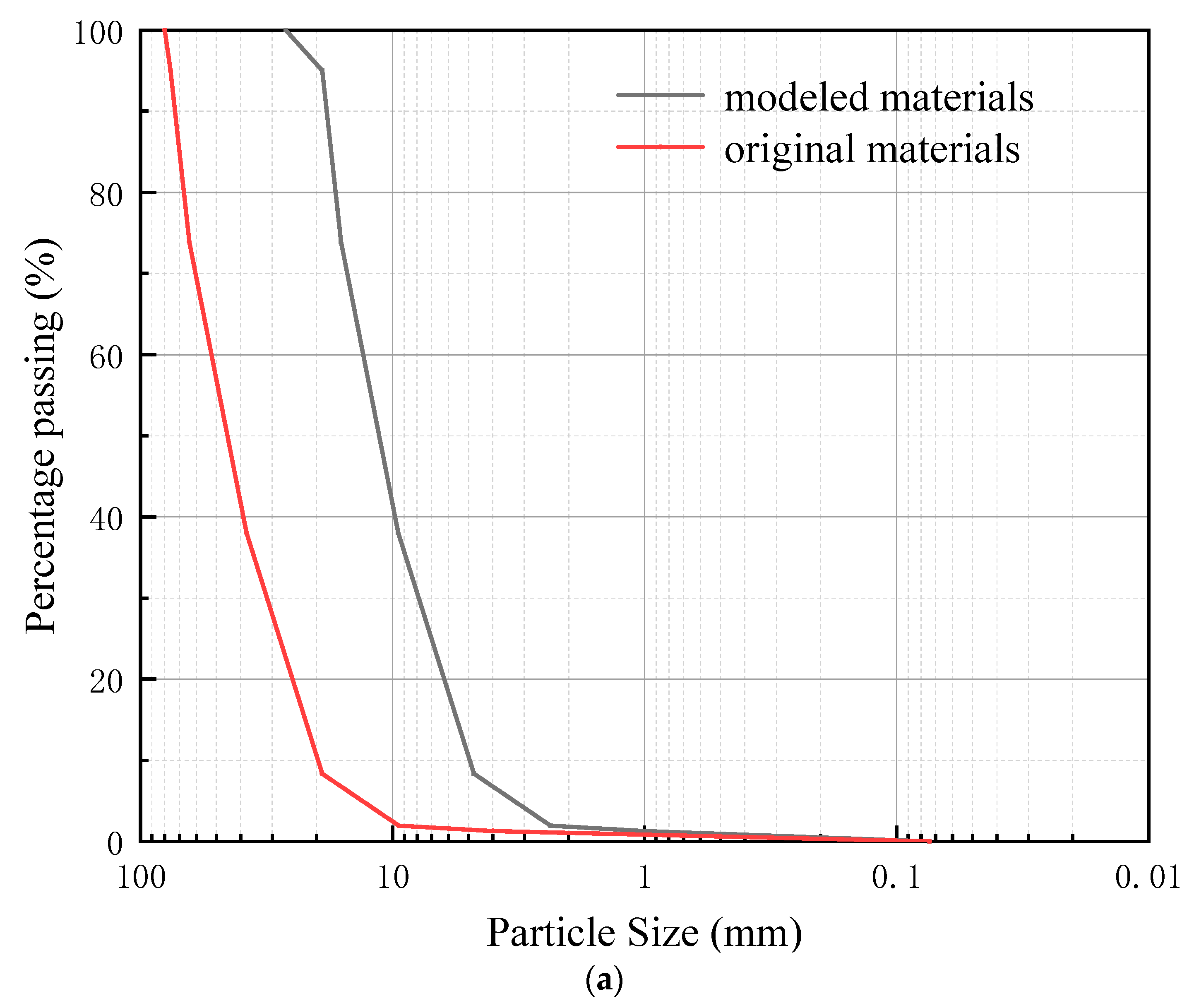
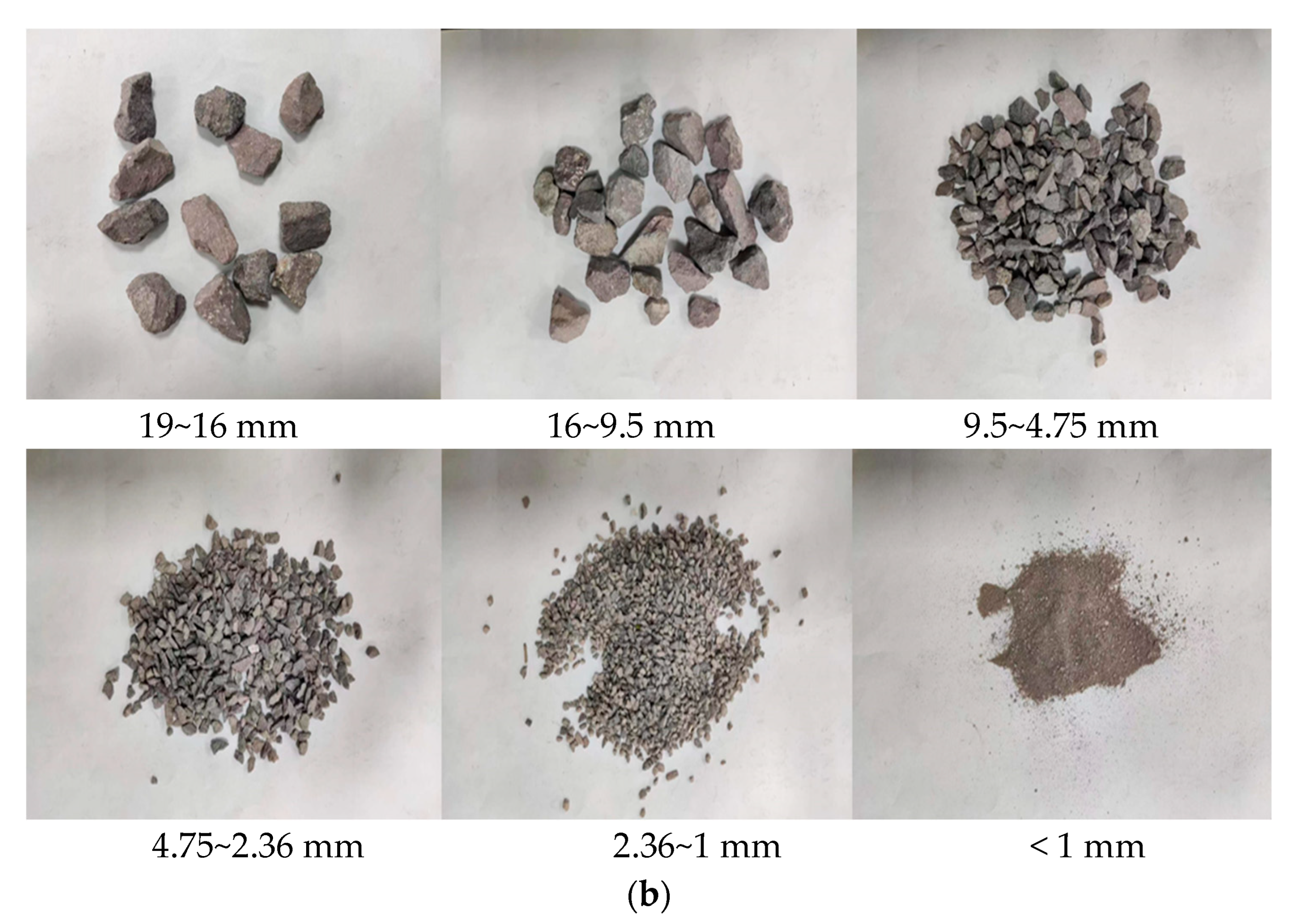


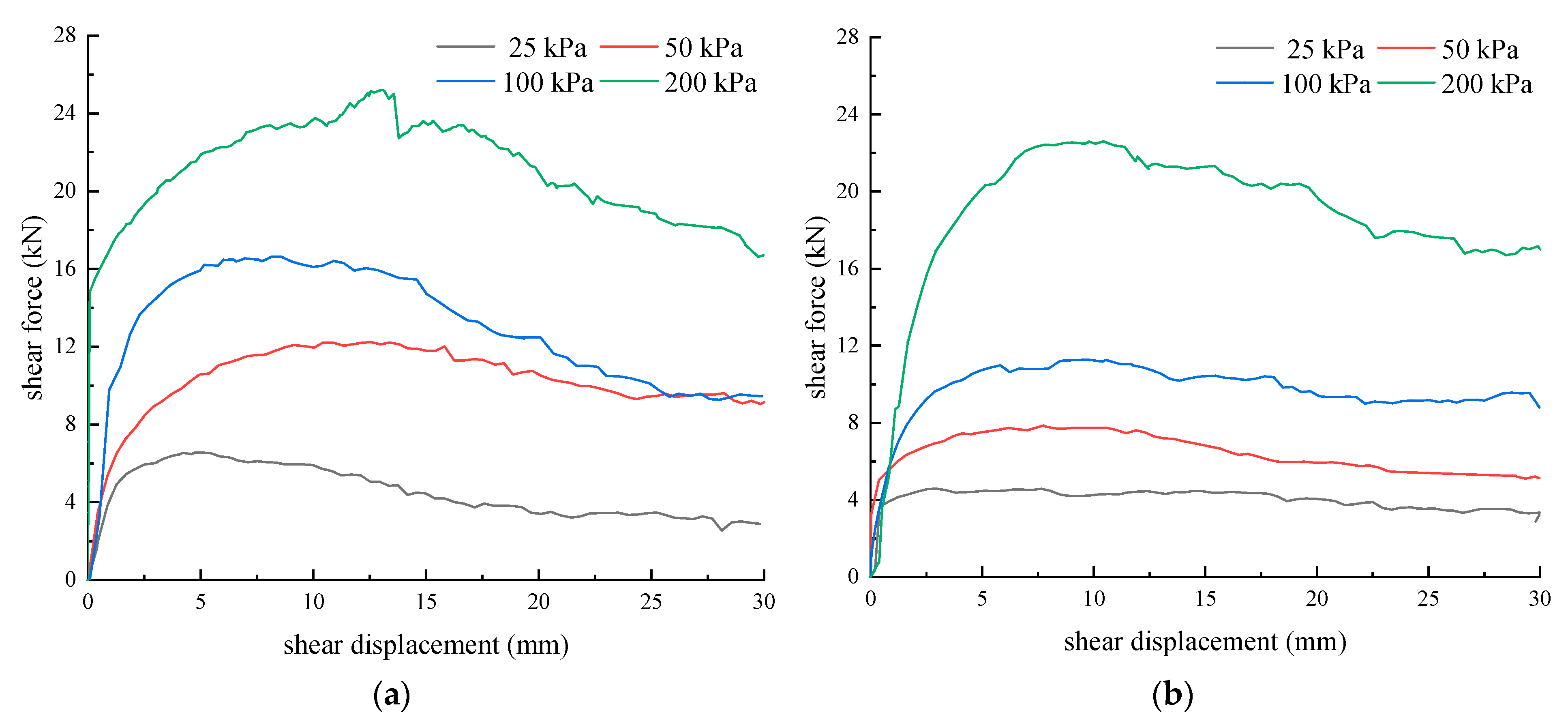

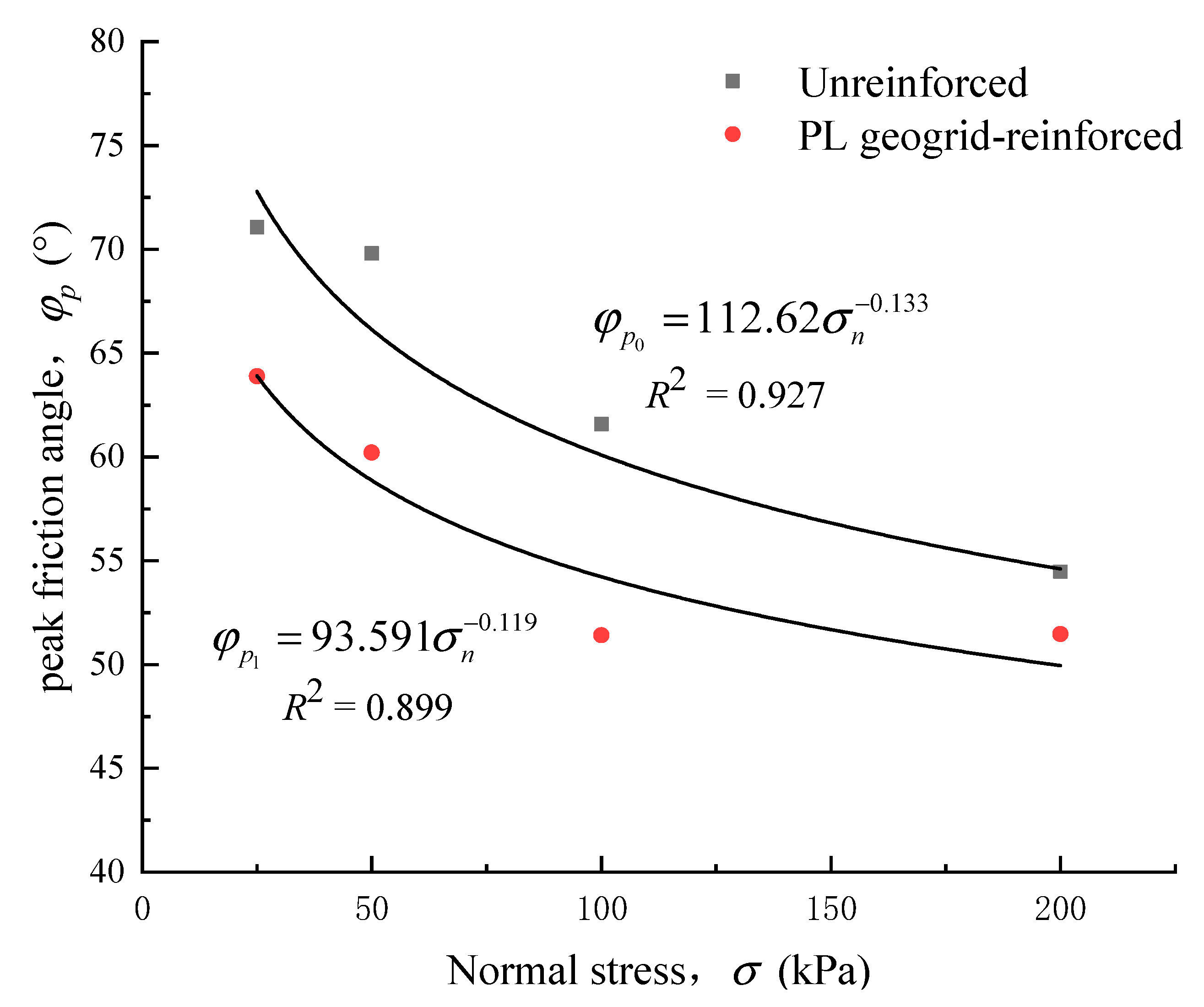
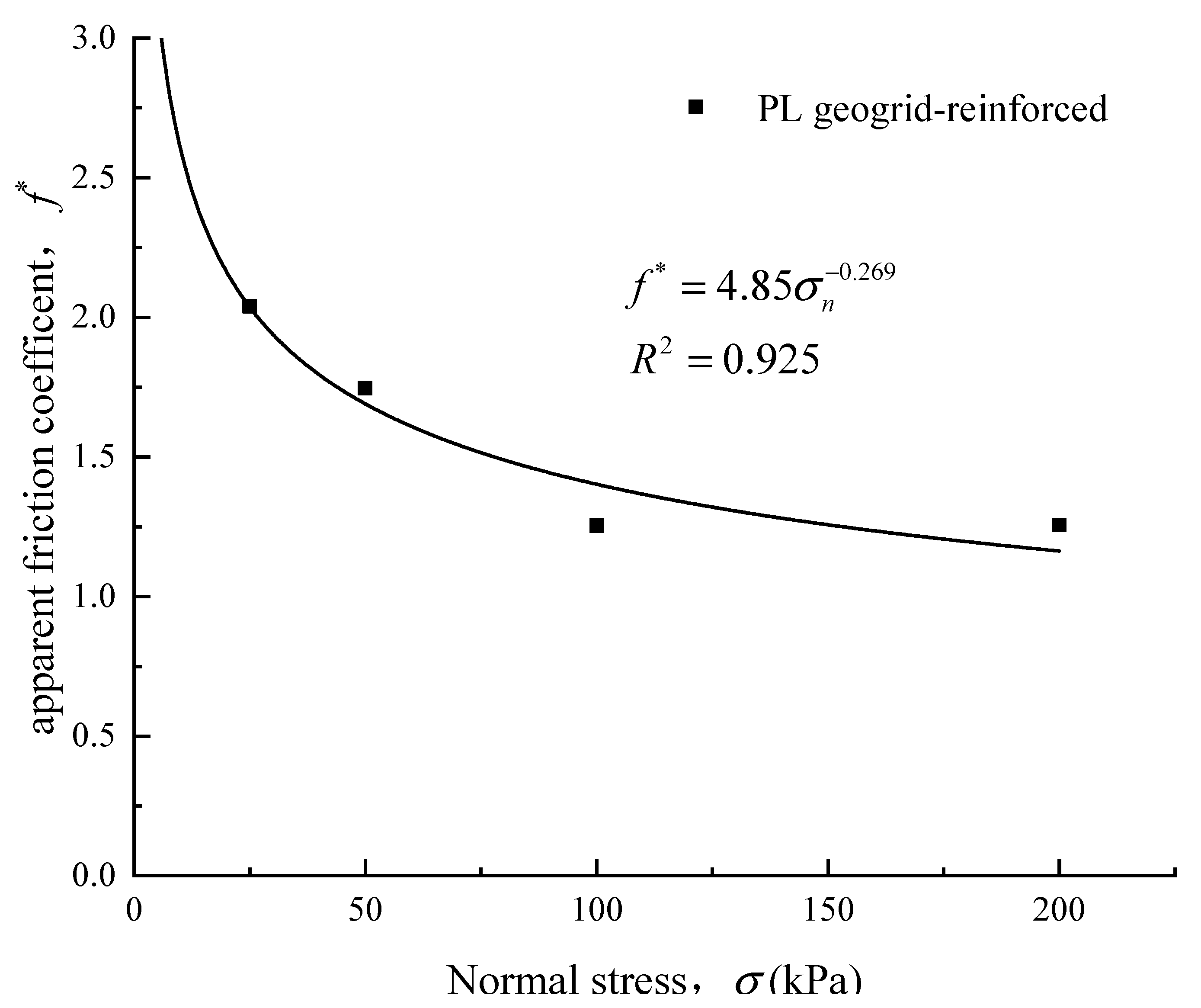


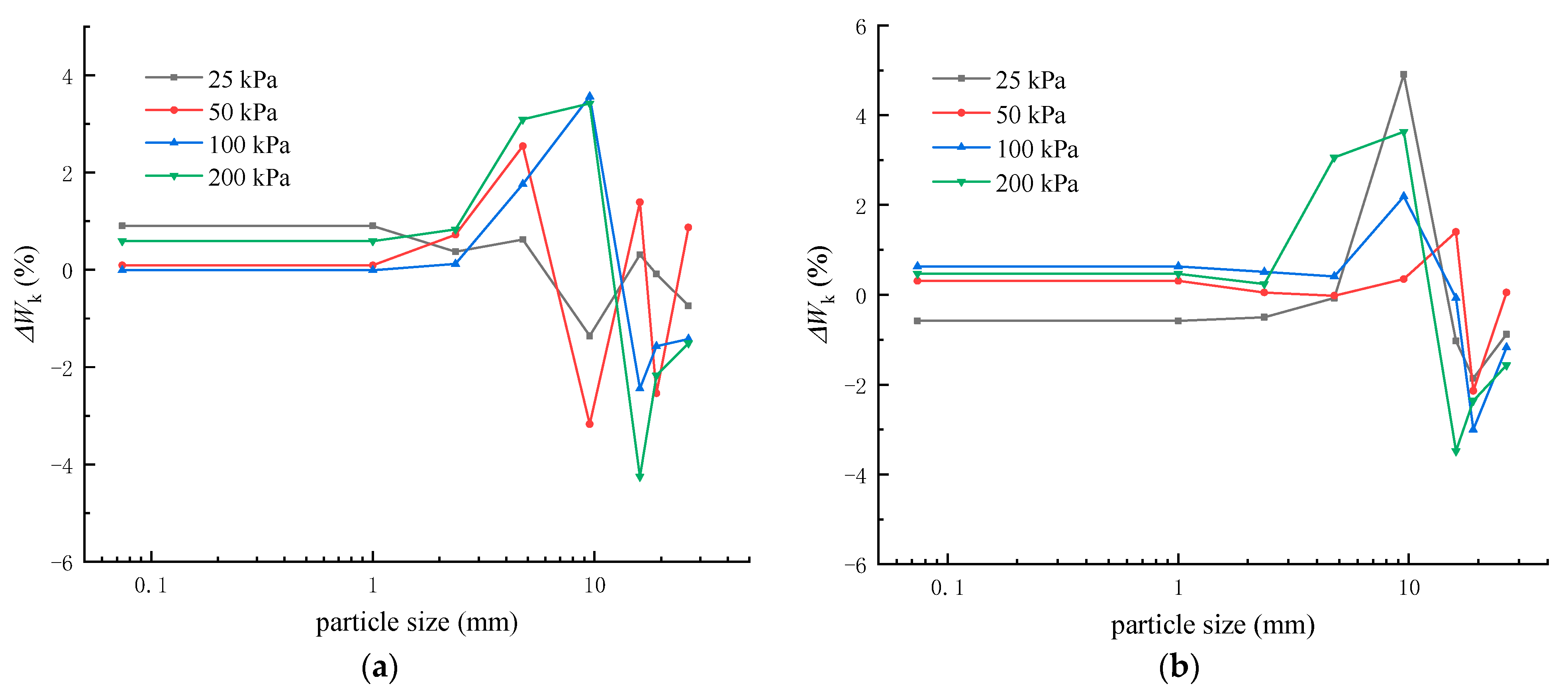

| Project | Performance |
|---|---|
| Load capacity | 30 kN |
| Displacement rate range | 0.003~3 mm/min |
| Horizontal range | 50 mm |
| Vertical range | 50 mm |
| Geogrid | Mass per Unit Area (g/m3) | Aperture Size (mm) | LD and TD Ribs Width (mm) | Ultimate Tensile Strength (kN/m) |
|---|---|---|---|---|
| ParaLink Geogrid | 860 | 90 × 930 | 60.90 | 581 |
Disclaimer/Publisher’s Note: The statements, opinions and data contained in all publications are solely those of the individual author(s) and contributor(s) and not of MDPI and/or the editor(s). MDPI and/or the editor(s) disclaim responsibility for any injury to people or property resulting from any ideas, methods, instructions or products referred to in the content. |
© 2023 by the authors. Licensee MDPI, Basel, Switzerland. This article is an open access article distributed under the terms and conditions of the Creative Commons Attribution (CC BY) license (https://creativecommons.org/licenses/by/4.0/).
Share and Cite
Wang, L.; Zhu, Q.; Jia, Y.; Li, H. Experimental Study on the Interface Characteristics of Reinforced Crushed Rock Cushion Layer Based on Direct Shear Tests. Materials 2023, 16, 5858. https://doi.org/10.3390/ma16175858
Wang L, Zhu Q, Jia Y, Li H. Experimental Study on the Interface Characteristics of Reinforced Crushed Rock Cushion Layer Based on Direct Shear Tests. Materials. 2023; 16(17):5858. https://doi.org/10.3390/ma16175858
Chicago/Turabian StyleWang, Liangliang, Qianlong Zhu, Yan Jia, and Hu Li. 2023. "Experimental Study on the Interface Characteristics of Reinforced Crushed Rock Cushion Layer Based on Direct Shear Tests" Materials 16, no. 17: 5858. https://doi.org/10.3390/ma16175858
APA StyleWang, L., Zhu, Q., Jia, Y., & Li, H. (2023). Experimental Study on the Interface Characteristics of Reinforced Crushed Rock Cushion Layer Based on Direct Shear Tests. Materials, 16(17), 5858. https://doi.org/10.3390/ma16175858






